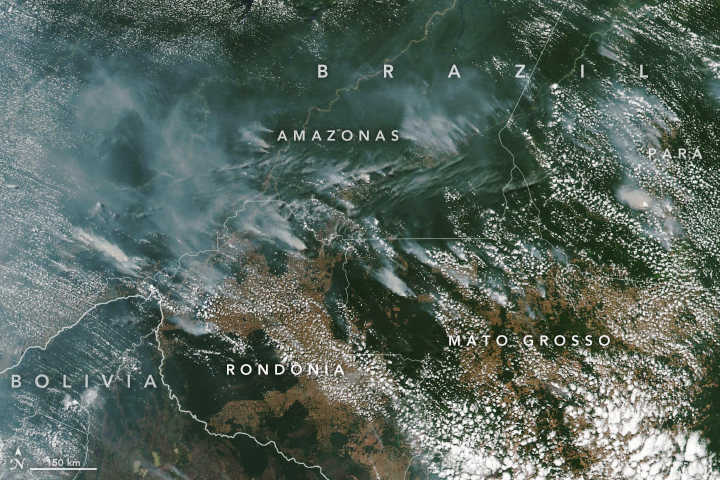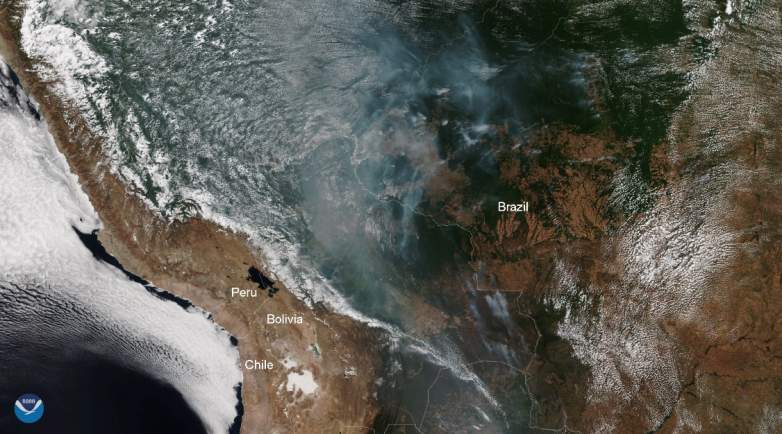
There’s a lot of debate right about what is causing the forest fires in the Amazon right now. More than likely, the answer is that a variety of sources have contributed to causing the fires in Brazil, including deforestation and cattle ranching.
Wildfires Are Worse in Certain Parts of Brazil Compared to This Time Last Year
Wildfires often occur in Brazil during this time of year. According to NASA, fires in the Amazon increase in July and August and reach their peak in September, typically stopping by November. There’s debate about just how much worse this year is than other years, or if it is worse. The answer depends on the source you read.
Data from NASA and the Global Fire Emissions Database indicated that total fire activity in the Amazon is just below average compared to the last 15 years, but has been above average specifically in Amazonas and Rondonia (where the current fires are burning.) It’s been below average in Mato Grosso and Para, which is why the total is below average at the moment. Globo, however, noted that Brazilian Amazon fires were doubled from January to August 2019 compared to the same time period in 2018, with fires in Rondonia up by nearly 190 percent.
A government monitoring system has said that fires in Brazil are up 84 percent from this same time period last year, ABC 11 reported. INPE has said that this year is worse than normal.
Brazil’s Cattle Business Is Contributing to the Fires
One source of the fire is deforestation to make room for Brazil’s cattle export business. Brazil is the largest cattle exporter in the world and has 200 million head of cattle, Express reported. Sometimes fires are set intentionally so land can be cleared for cattle ranching.
The Union of Concerned Scientists noted: “Just four commodities—beef, soy, palm oil, and wood products—drive the majority of tropical deforestation… Of the four major deforestation drivers, beef has by far the largest impact. Converting forest to pasture for beef cattle, largely in Latin America, is responsible for destroying 2.71 million hectares of tropical forest each year—an area about the size of the state of Massachusetts—in just four countries. This is more than half of tropical deforestation in South America, and more than five times as much as any other commodity in the region.”
The Yale School of Forestry and Environmental Studies reported that cattle ranching is the largest source of deforestation in the Amazon (and deforestation is a large contributing factor to forest fires.)
Brazil’s President Claimed, Without Evidence, that NGOs Were Setting the Fires on Purpose. NGOs Say His Policies Are Contributing to the Fires.
Brazil President Jair Bolsonaro is claiming that the fires were started on purpose by workers of non-profit organizations who are fighting deforestation. He is claiming the fires were set to call attention to the NGOs’ funding cuts.
In his speculation, Bolsonaro didn’t name any NGOs in particular or provide any evidence of his claims, Globo reported. In a translated quote he said: “The issue of burning in the Amazon, which in my opinion may have been potentiated by NGOs, because they lost money…”
Bolsonaro also said that governors in northern Brazil weren’t trying to help fight the fires, but were using the fires as an opportunity to put blame on the federal government. He didn’t name anyone in particular.
Meanwhile, NGOs have blamed Bolsonaro’s policies for the increase in fires, ABC 11 reported. They say his pro-development policies led to an increase in deforestation and an increase in fires. Conservationists have said that Bolsonaro’s encouraging loggers to clear the land has helped increase fires, Express reported.
Droughts & Deforestation Are Contributing to the Fires
Environmental Minister Ricardo Salles said the dry, hot weather and increased winds contributed to the fires, Globo reported.
NASA has said that an increasing frequency of droughts, combined with human activity, is the cause of the fires. NASA said in a statement: “The intensity and frequency of droughts in turn, have been linked with increases in regional deforestation and anthropogenic climate change.”
NASA’s said in a statement:
Wildfires there today are caused by a combination of droughts and human activity; the intensity and frequency of droughts in turn, have been linked with increases in regional deforestation and anthropogenic climate change. In fact, the Amazon rainforest has experienced three major droughts, considered “once-in-a-century events” in 2005, 2010, and in 2015-2016.
When trees have less water during droughts, they shed extra leaves or die, leaving leaf litter and detritus on the forest floor. Without a dense canopy to retain moisture, much of the forest’s humidity is lost. Additionally, the practice of “selective logging” of specific tree species and “slash and burn” agriculture opens the canopy further, which also dries out the understory and forest edges.
Ricardo Mello of the World Wide Fund for Nature Amazon Program also said that the fires were caused by an increase in deforestation, BBC reported.
So in short, a combination of drought conditions and deforestation have caused the current fires in the Amazon. Much of that deforestation is led by cattle ranching in the region.
READ NEXT: Amazon Rainforest Fires: Maps Show Smoke & Fire Spreading in Brazil

